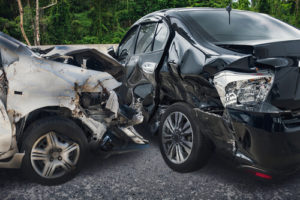Mild traumatic brain injuries, known as concussions, have frequently been in the news in recent years as the National Football League, college, high school and youth sports leagues have had to confront the prevalence of concussions among athletes.
NFL concussion protocols and others modeled after them focus on getting the injured player back in the game. A concussion is defined as an injury to the brain that results in temporary loss of normal brain function. In addition to sports injuries, concussions can occur in car accidents, falls, being struck in the head and other types of accidents. Some can have lingering effects. What if the brain does not fully normalize after the prescribed period of rest? Can a concussion cause permanent brain damage?
Our brain injury lawyers in Kentucky assist clients and the families of individuals who have suffered traumatic brain injuries (TBIs) in accidents caused by the negligence of other. We’ve seen brain injury survivors recover and rebuild their lives. There is evidence that repeated concussions can cause lasting damage to the brain.
What Is a Concussion?
A concussion is a supposedly short-lived change in brain function following a blow or sudden jolt to the head. This may be due to the victim hitting their head or getting hit in the head, such as in a slip and fall or car accident. The impact leaves the individual dazed and confused for a few moments, a symptom of the brain not functioning properly. Sometimes a concussion victim is knocked unconscious.
People with concussions often report a brief period of amnesia or forgetfulness, typically including not remembering what happened immediately before or after they were injured.
Other common symptoms include:
- Headache
- Double or blurry vision
- Dizziness or imbalance
- Nausea or vomiting
- Memory loss
- Ringing ears
- Difficulty concentrating
- Sensitivity to light
- Loss of smell or taste
- Trouble falling asleep.
Anyone who experiences these symptoms after suffering a blow to the head should see a doctor as soon possible. If symptoms worsen after an initial medical exam, further medical care is required.
Most people with concussions recover completely in 10 to 14 days. Some people have symptoms for several weeks before gradually getting better.
But the American Association of Neurological Surgeons says that there is no such thing as a minor concussion.
“In most cases, a single concussion should not cause permanent damage,” the Association says. “A second concussion soon after the first one does not have to be very strong for its effects to be permanently disabling.”
What Are the Long-Term Effects of a Concussion?
The effects of a concussion persist in some people. One study found long-term structural damage to the brain in patients who had suffered a single mild traumatic brain injury (MTBI), or concussion.
As published in the journal Radiology, the study at NYU Langone School of Medicine found that MRIs showed measurable global and regional brain atrophy in patients one year after they suffered concussions.
“This is the first study that shows brain areas undergo measurable volume loss after concussion,” Yvonne W. Lui, M.D., Neuroradiology section chief and assistant professor of radiology at NYU Langone School of Medicine, said in a news release accompanying the study. “In some patients, there are structural changes to the brain after a single concussive episode.”
These changes correlated with detrimental changes in memory, attention and anxiety, the release says.
The NYU researchers used three-dimensional magnetic resonance imaging (MRI) to determine regional gray matter and white matter volumes and correlated these findings with other clinical and cognitive measurements. The study involved examining 29 concussion patients with post-traumatic symptoms after injury (with 19 followed at one year) and 22 matched controls (with 12 followed at one year).
According to WebMD, previous research has shown that 10 percent to 20 percent of concussion patients continue to experience symptoms more than a year after their head injury.
Persistent post-concussive symptoms, or post-concussion syndrome, is a recognized diagnosis for concussion symptoms that last beyond the initial injury’s expected recovery period. The most common symptoms are headache, dizziness and sleep problems.
Some experts believe persistent post-concussion symptoms are caused by structural damage to the brain or disruption of the messaging system within the nerves, which happened in the initial impact that caused the concussion, the Mayo Clinic says. Others believe persistent post-concussive symptoms are related to psychological factors.
A history of depression, anxiety, post-traumatic stress disorder (PTSD), significant life stressors, a poor social support system and lack of coping skills are more common in people who develop persistent post-concussive symptoms compared with those who don’t.
Studies have also found increasing age to be a risk factor for persistent post-concussive symptoms.
Contact a Kentucky Brain Injury Lawyer
When a patient’s concussion symptoms persist or there are indications that the person has suffered some permanent cognitive deficits, the patient and family members must consider how they will address the costs and losses caused by the patient’s long-term needs. If the original concussion resulted from an incident someone else caused – a car accident, a slip and fall accident, a physical assault – they may seek compensation from the person or party at fault.
In many cases, a person who sustained a mild concussion in an accident should recover quickly. But, if symptoms of a concussion persist and continue to result in medical bills, lost work time and/or loss of enjoyment of life, you should discuss your legal options with a qualified personal injury attorney.
In most personal injury cases, Kentucky’s statute of limitations (KRS Chapter 413.140) provides one year after the injury or diagnosis of the injury to file a claim. This provides time to determine that a concussion has not cleared up in the customary amount of time and to seek legal advice about a claim to recover your ongoing medical costs and losses.
An attorney still needs time to thoroughly investigate the accident, determine who is financially liable, compile evidence for a legal claim, and contact the insurance company to try to negotiate a settlement. You should contact the Kentucky brain injury attorneys at Morgan, Collins, Yeast & Salyer as soon as possible to discuss your options after suffering a head injury that leads to medical costs, time away from work, and pain and suffering or emotional distress.
Morgan, Collins, Yeast & Salyer offers a free initial consultation and pursues personal injury cases on a contingency fee basis. You won’t have to pay us unless we recover money for you. Contact us today at (877) 809-5352 or online.
The post Can a Concussion Cause Permanent Brain Damage? appeared first on Morgan, Collins, Yeast & Salyer.
from Morgan, Collins, Yeast & Salyer https://www.kentuckycourage.com/blog/can-a-concussion-cause-permanent-brain-damage/
via https://www.kentuckycourage.com


